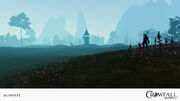JackalBark (talk | contribs) |
JackalBark (talk | contribs) |
||
| Line 10: | Line 10: | ||
Each Campaign is broken into seasons: Spring, Summer, Fall, and Winter. At the end of the last season, the Campaign will end, a victor is declared, the Crows leave the world, and that Campaign goes offline forever. |
Each Campaign is broken into seasons: Spring, Summer, Fall, and Winter. At the end of the last season, the Campaign will end, a victor is declared, the Crows leave the world, and that Campaign goes offline forever. |
||
| − | Within these seasons there is a day/night cycle, and every “midnight” in game, the Hunger will consume a bit more of the world. Monsters will become twisted and corrupted, food resources will become more scarce, and the world will become riddled with Hunger – which the players will have to destroy if they want to continue to harvest resources to survive. Each season will also include a new drawing of Seasonal Cards for [[Campaigns# |
+ | Within these seasons there is a day/night cycle, and every “midnight” in game, the Hunger will consume a bit more of the world. Monsters will become twisted and corrupted, food resources will become more scarce, and the world will become riddled with Hunger – which the players will have to destroy if they want to continue to harvest resources to survive. Each season will also include a new drawing of Seasonal Cards for [[Campaigns#Divine Favor and Scoring|Divine Favor]]. |
=== Embargo === |
=== Embargo === |
||
| Line 35: | Line 35: | ||
=== Forts === |
=== Forts === |
||
| − | Forts are mid-sized capturable structures, worth a medium amount of [[Campaigns# |
+ | Forts are mid-sized capturable structures, worth a medium amount of [[Campaigns#Divine Favor and Scoring|conquest points]]. Forts can only be captured during their specific siege window (typically once a day), displayed in the Siege Schedule portion of the Leaderboard. During an available siege window, a Fort can be claimed in much the same way as Outposts: slay the guards and stand within the capture circle. Forts produce a bounty of building materials that are used to create and upgrade the walls and buildings in Keeps and Castles, so having at least one Fort is incredibly valuable for owning a Keep or Castle. |
A guild with control of a fort is still considered "landless" for the purposes of Divine Favor cards. |
A guild with control of a fort is still considered "landless" for the purposes of Divine Favor cards. |
||
=== Keeps and Castles === |
=== Keeps and Castles === |
||
| − | Keeps and castles are the largest capturable structures in Campaigns and are worth the most [[Campaigns# |
+ | Keeps and castles are the largest capturable structures in Campaigns and are worth the most [[Campaigns#Divine Favor and Scoring|conquest points]]. Keeps and Castles can only be captured during their specific siege window (typically twice a week), displayed in the Siege Schedule portion of the Leaderboard. Keeps and Castles, unlike Forts and Outposts, require the winning faction to plant a new [[Tree of Life]] within the Keep or Castle. Tree of Life Saplings can be purchased from the Ranger near the Tree of Life in the Temple. During an available siege window, the attackers must breach the walls, destroy the wards that protect the structure, kill the Tree of Life, and plant their own. |
These are the only structures that count as controlling land for the purposes of Divine Favor cards that specify a guild must be "landless". |
These are the only structures that count as controlling land for the purposes of Divine Favor cards that specify a guild must be "landless". |
||
Revision as of 23:05, 16 December 2020
Campaign Worlds
Campaign Worlds are procedurally generated worlds that exist within the Crowfall universe. The "Campaigns" refer to time-limited worlds with a win objective (as opposed to the Eternal Kingdoms, God's Reach, and Infected which are not time-limited and have no win conditions). Currently, Campaign Worlds include the Shadow and Dregs.
Lore
The universe of Crowfall is being consumed by a force called the Hunger. Worlds that have been touched by the Hunger are doomed to be consumed by it. They are called the Dying Worlds. Using ancient magic, the gods have amassed armies of Crows who they send to scavenge the Dying Worlds and lay claim to the lands before they're destroyed. The Crows fight against each other in the name of their deity or allegiance, seeking to collect resources before the end of the final winter.
Campaign Gameplay
Seasons
Each Campaign is broken into seasons: Spring, Summer, Fall, and Winter. At the end of the last season, the Campaign will end, a victor is declared, the Crows leave the world, and that Campaign goes offline forever.
Within these seasons there is a day/night cycle, and every “midnight” in game, the Hunger will consume a bit more of the world. Monsters will become twisted and corrupted, food resources will become more scarce, and the world will become riddled with Hunger – which the players will have to destroy if they want to continue to harvest resources to survive. Each season will also include a new drawing of Seasonal Cards for Divine Favor.
Embargo
Each Campaign will have its own embargo rules; that is, rules on what items can be brought into and taken out of that particular Campaign. Most Campaigns will have an Import number and an Export number. Imports control the number of items or item stacks that you can bring with you into the Campaign. For example, if you have a sword, a shield, and one stack of five apples, this would remove three import tokens from your account and allow you to bring these items into the Campaign. The export tokens work similarly; if, at the conclusion of a Campaign you have five stacks of rare ore, you will need to spend five export tokens to send them to your Vault.
Keep in mind that these import and export tokens are based on stacks of items (in such cases as items are able to be stacked). Because five apples are only one stack, they only require one token to import or export. Conversely, five stacks of apples (that is, 500 apples total) would require five tokens to import or export.
Import and export values are shared across all vessels on one account. If, for example, you use up all of your export tokens moving items to your Vault from your Guinecean Duelist, you won't be able to export any items from your Centaur Cleric.
Runegates and Zones
Campaign Worlds are made up of multiple floating islands (also called zones) connected by runegates. Each of these zones will have a unique, procedurally generated map and may be up to 5,120m by 5,120m in size.
Temple zones are where your character spawns the first time you enter that Campaign. They consist of a Hero Statue, sacrifice braziers, a market and crafting area, and a vault. Temples are safe areas; only players of the same faction may enter their specific temple.
Free cities are safe zones that everyone can access. The free city includes a market area where vendors may be set up.
Adventure zones are not safe. It is here that the outposts, forts, and keeps are located, along with various adventuring areas such as canyons, forests, and villages.
Outposts

Outpost
Outposts are the smallest capturable structures in Campaigns and thus worth the fewest number of conquest points. Outposts can be captured at any time by simply killing the outpost guards and standing within the capture circle. These are useful because they can offer strategic services like closer respawn areas, sacrifice opportunities, and banking opportunities.
A guild with control of an outpost is still considered "landless" for the purposes of Divine Favor cards.
Forts
Forts are mid-sized capturable structures, worth a medium amount of conquest points. Forts can only be captured during their specific siege window (typically once a day), displayed in the Siege Schedule portion of the Leaderboard. During an available siege window, a Fort can be claimed in much the same way as Outposts: slay the guards and stand within the capture circle. Forts produce a bounty of building materials that are used to create and upgrade the walls and buildings in Keeps and Castles, so having at least one Fort is incredibly valuable for owning a Keep or Castle.
A guild with control of a fort is still considered "landless" for the purposes of Divine Favor cards.
Keeps and Castles
Keeps and castles are the largest capturable structures in Campaigns and are worth the most conquest points. Keeps and Castles can only be captured during their specific siege window (typically twice a week), displayed in the Siege Schedule portion of the Leaderboard. Keeps and Castles, unlike Forts and Outposts, require the winning faction to plant a new Tree of Life within the Keep or Castle. Tree of Life Saplings can be purchased from the Ranger near the Tree of Life in the Temple. During an available siege window, the attackers must breach the walls, destroy the wards that protect the structure, kill the Tree of Life, and plant their own.
These are the only structures that count as controlling land for the purposes of Divine Favor cards that specify a guild must be "landless".
Divine Favor and Scoring
Divine Favor is the system that provides points for your faction or guild towards winning the Campaign. Divine Favor consists of a deck of cards, each with a unique task that awards a certain number of points to the faction that completes it in first, second, and third place. They are divided into three categories: Glory, Wealth, and Power.

Campaign Leaderboard showing Divine Favor Cards
- Glory is generally PvE-oriented, including sacrificing items to specific gods.
- Wealth is generally commerce-oriented, and can include pouring resources into improving buildings and fortifications.
- Power is generally PvP and conquest-oriented, and often relies heavily on capture points gained from sieging and holding capturable structures.
There are three Campaign Cards that remain static for the entire Campaign. There are also three Season Cards which change with each season. Each category will have one Campaign Card and one Season Card available for completion.
While alliances are available for guilds, these do not directly affect the guilds' score in the Campaign. Rather, guilds can make use of the alliances system to team up with other guilds for help in capturing strongholds from otherwise-entrenched enemies, safely gathering valuable resources, or trading among each other.
Rewards
While the bragging rights of winning (as well as the resources gathered within the Campaign) can be its own reward, additional rewards packages are available depending on where your faction or guild places at the end of the Campaign. These rewards, unlike items taken into or gathered within the Campaign itself, are not subject to embargo. Instead, rewards will be delivered directly to your Vault.
